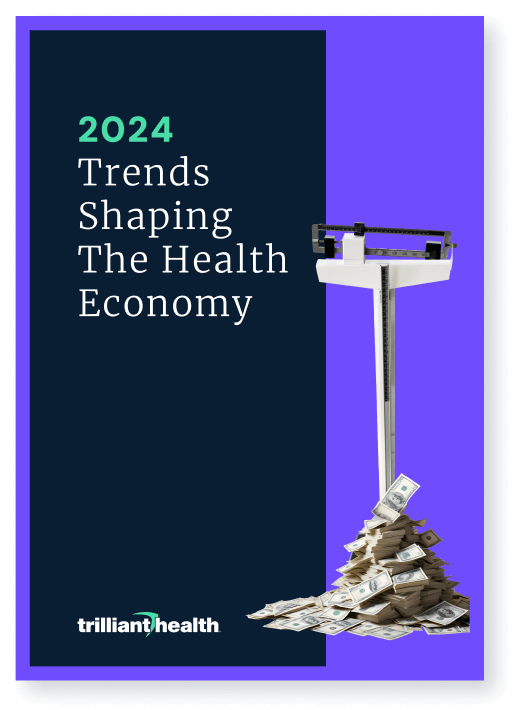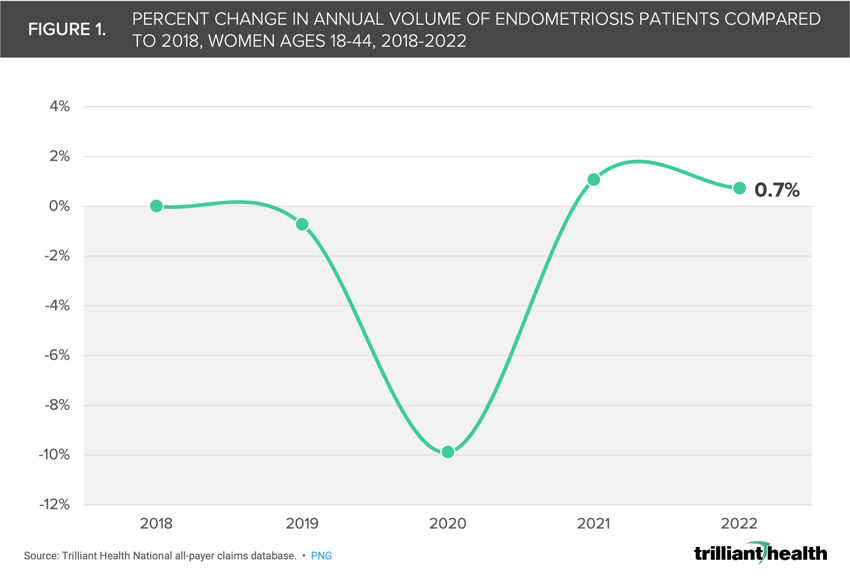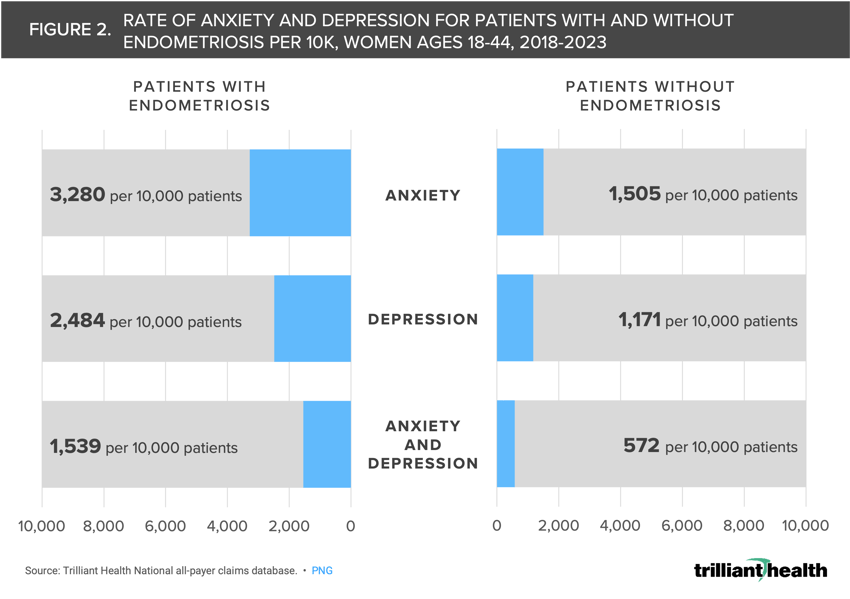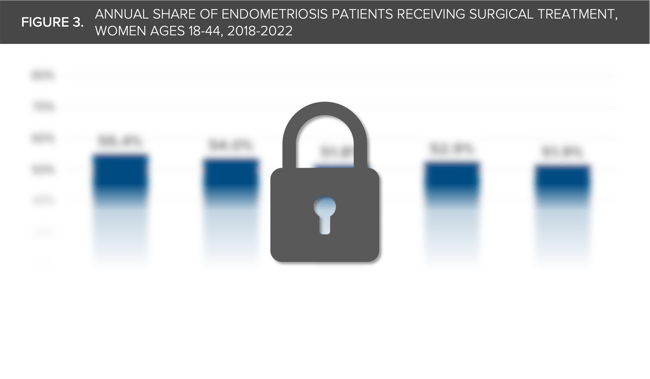The Compass
Sanjula Jain, Ph.D. | March 17, 2024Rates of Depression and Anxiety Are Comparatively Higher Among Women with Endometriosis
Key Takeaways
-
Endometriosis volumes have remained relatively stable over the past five years, with just 0.7% more patients receiving care for endometriosis in 2022 than in 2018.
-
Despite its severity and debilitating physical side effects, the connection between mental health and endometriosis is not well understood.
-
Women ages 18 to 44 with endometriosis had higher rates of anxiety and depression (1,539 per 10K) compared to those without endometriosis (572 per 10K).
-
Compass+ Exclusive: Endometriosis Disease Burden is Not Commensurate with Demand for Related Surgical Procedures
You are currently viewing the public version of The Compass.
To unlock additional analyses, upgrade your subscription to the Compass+ platform.
March is Endometriosis Awareness Month, recognizing a debilitating chronic condition characterized by endometrial tissue growing outside of the uterus.1 While the most common symptom of endometriosis is pelvic pain, researchers have also found a correlation between endometriosis and mental health conditions, such as depression, anxiety and eating disorders.2,3,4,5 While research has shown that mental health conditions can exacerbate comorbid physical health conditions, the intersection of mental health and women’s health remains insufficiently explored. To improve accurate and timely diagnosis and treatment, it is crucial to understand the extent to which endometriosis patients are more likely to experience behavioral health conditions. Thus, this study examined the prevalence of anxiety and depression in women with and without endometriosis.
Background
Despite the debilitating side effects (e.g., pelvic pain, fatigue, associated intestinal conditions) and long-term health implications (e.g., infertility and cancer) associated with the condition, endometriosis remains inadequately researched.6,7,8 In 2022, more than 100 new endometriosis codes were added to the International Classification of Diseases (ICD), a substantial addition to the original nine codes that had been in place since the 1970s. 9,10 The prevalence of endometriosis among U.S. women of reproductive age remains unclear, with research estimating it could range from 0.8% to 11%. 11,12,13,14 The volume of women being treated for or diagnosed with endometriosis has remained relatively stable over the past five years, despite an expected drop in 2020 amid the COVID-19 pandemic. In 2022, just 0.7% more patients received care for endometriosis than in 2018 (Figure 1).
While the impact of endometriosis on mental health is not fully understood, the physical symptoms of endometriosis are well documented.15 While some evidence indicates that the inflammation linked to endometriosis may contribute to behavioral health comorbidities, other studies indicate that chronic pain serves as the primary mediator of depression and anxiety in patients with endometriosis.16,17 Moreover, the prevalence of behavioral health comorbidities among patients with endometriosis remains unclear, posing numerous challenges for the providers diagnosing and treating endometriosis.
Analytic Approach
Leveraging Trilliant Health's national all-payer claims database, we analyzed women ages 18 to 44 in two cohorts: those diagnosed with endometriosis and those without a diagnosis, between Q1 2018 and Q2 2023. We analyzed the share of women ages 18 to 44 diagnosed with anxiety, depression or both conditions. Next, we examined the surgical volume of CPT code 58662 (laparoscopy, surgical; with fulguration or excision of lesions of the ovary, pelvic viscera, or peritoneal surface), which are surgical interventions related to endometriosis diagnosis and treatment. To be included in the analysis, a patient was required to have had three visits within the study period.
Findings
The prevalence rates of anxiety, depression and both conditions were higher for patients with endometriosis. Among patients with endometriosis, the prevalence rate of anxiety was 3,280 per 10K, compared to 1,505 per 10K among women without endometriosis (Figure 2). The prevalence rate for depression was 2,484 per 10K among endometriosis patients, while the depression prevalence rate for non-endometriosis patients was 1,171 per 10K.
Compass+ Exclusive: Endometriosis Disease Burden is Not Commensurate with Demand for Related Surgical Procedures
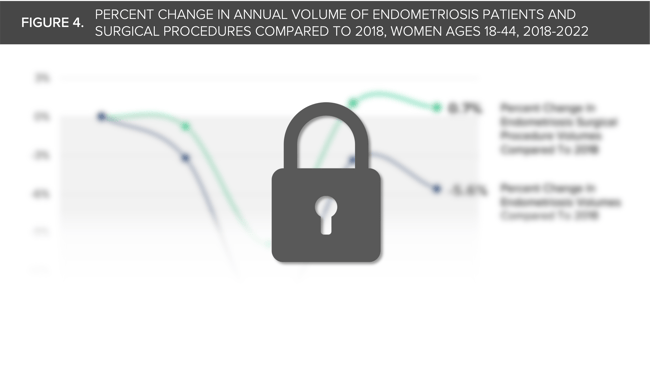 Unlock the complete analysis with Compass+
Unlock the complete analysis with Compass+
Conclusion
While the prevalence rates of anxiety and depression are high among women with and without endometriosis, women with endometriosis displayed a higher share of behavioral health comorbidities compared to patients without endometriosis. Our past research has shown that the existence of a behavioral health condition can exacerbate other physical comorbidities (e.g., diabetes), and failure to adequately treat a diagnosed behavioral health condition can lead to higher complexity of care (e.g., frequent emergency department visits).21 Given the growing cost of care, increasing demand for behavioral healthcare and the inadequate projected supply for specialized psychiatrists, monitoring these trends going forward will be critical.22,23 Are higher rates of behavioral health conditions among women with endometriosis attributable to endometriosis alone, or are other factors (e.g., the stress of delayed diagnosis, lack of recognition of pain, lack of access to long-term treatments), correlated with higher than average rates for anxiety and depression? If women are increasingly utilizing non-surgical treatment options (i.e., treatments that can temporarily alleviate discomfort without addressing the root causes of endometriosis pain), what will the downstream impacts be? To what extent will new treatment paradigms (e.g., non-surgical pharmacological treatments) for endometriosis decrease surgical procedure volumes?
Given the considerably high prevalence of endometriosis among in women of reproductive age, a greater focus, both in terms of research and investment, on this condition and its associated physical and mental risk factors have never been more imperative. By investing in mental health support services and research exploring the mechanistic relationship between endometriosis and mental health, stakeholders may improve outcomes for women with endometriosis while potentially reducing long-term healthcare costs associated with untreated mental and physical health conditions.
- Women's Health
- Specialty Care
- Behavioral Health
- Disease Burden
You are currently viewing a free preview of our premium studies. To receive new studies weekly, upgrade to Compass+.
Sign UpSee more with Compass+
You are currently viewing the free version of this study. To access the full study and more leading research on the health economy, subscribe to Compass+.
Sign Up for Compass+






















